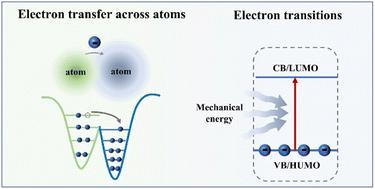当前位置:
X-MOL 学术
›
J. Mater. Chem. A
›
论文详情
Our official English website, www.x-mol.net, welcomes your feedback! (Note: you will need to create a separate account there.)
Tribocatalysis mechanisms: electron transfer and transition
Journal of Materials Chemistry A ( IF 11.9 ) Pub Date : 2023-02-13 , DOI: 10.1039/d2ta08105a Xinnan Li 1 , Wangshu Tong 1 , Jing Shi 1 , Yunfan Chen 1 , Yihe Zhang 1 , Qi An 1
Journal of Materials Chemistry A ( IF 11.9 ) Pub Date : 2023-02-13 , DOI: 10.1039/d2ta08105a Xinnan Li 1 , Wangshu Tong 1 , Jing Shi 1 , Yunfan Chen 1 , Yihe Zhang 1 , Qi An 1
Affiliation

|
Tribocatalysis is an emerging technology that can convert mechanical energy into chemical energy to degrade organic pollutants. The two widely used tribocatalysis mechanisms are the electron transfer and transition mechanisms. Currently, there is no definitive criterion to determine which mechanism is best employed for proper implementation in a tribocatalysis reaction. In this review, research that compares the two mechanisms through their electronic structures as criteria for selection is discussed. The factors influencing the tribocatalysis performance as well as criteria for tribocatalysis mechanism selection are the surface state, energy band structure, and force. Finally, the proposed standard method to analyze the electronic state, relation between the catalyst and H2O (O2), energy band bending theory, and charge preservation for tribocatalysis must be explored for tribocatalysis mechanism development. This review seeks to elicit meaningful discussion for distinguishing the unique characteristics of the two existing mechanisms and understanding the details of tribocatalysis mechanisms.
中文翻译:

摩擦催化机制:电子转移和转变
摩擦催化是一种新兴技术,可以将机械能转化为化学能来降解有机污染物。两种广泛使用的摩擦催化机制是电子转移和过渡机制。目前,没有确定的标准来确定哪种机制最适合在摩擦催化反应中正确实施。在这篇综述中,讨论了通过电子结构作为选择标准来比较这两种机制的研究。影响摩擦催化性能的因素以及摩擦催化机制选择的标准是表面状态、能带结构和力。最后,提出了分析电子态、催化剂与 H 2 O (O 2), 能带弯曲理论和摩擦催化的电荷保存必须探索摩擦催化机制的发展。本综述旨在引发有意义的讨论,以区分两种现有机制的独特特征并了解摩擦催化机制的细节。
更新日期:2023-02-13
中文翻译:

摩擦催化机制:电子转移和转变
摩擦催化是一种新兴技术,可以将机械能转化为化学能来降解有机污染物。两种广泛使用的摩擦催化机制是电子转移和过渡机制。目前,没有确定的标准来确定哪种机制最适合在摩擦催化反应中正确实施。在这篇综述中,讨论了通过电子结构作为选择标准来比较这两种机制的研究。影响摩擦催化性能的因素以及摩擦催化机制选择的标准是表面状态、能带结构和力。最后,提出了分析电子态、催化剂与 H 2 O (O 2), 能带弯曲理论和摩擦催化的电荷保存必须探索摩擦催化机制的发展。本综述旨在引发有意义的讨论,以区分两种现有机制的独特特征并了解摩擦催化机制的细节。



























 京公网安备 11010802027423号
京公网安备 11010802027423号